10 Amazing Benefits of Bali Oranges, Turns Out It Can Help with Diet - Treat Flu
Here are some benefits of Bali oranges for your body's health. What are these benefits? Let's check it out KLovers.

Kapanlagi.com - Hajj and Umrah are religious rituals in Islam. Both are performed in the Holy Land, but some people still have difficulty distinguishing between Hajj and Umrah. In fact, Hajj and Umrah have fundamental differences. As Muslims, it is important to know the differences between Hajj and Umrah.
Because they must be performed in the Holy Land, Hajj and Umrah differ from other obligatory acts of worship such as prayer, fasting, and zakat. Hajj and Umrah are more recommended for those who are capable, both financially and physically. In addition, Hajj is also one of the five pillars of Islam, making it obligatory for those who are able.
So what are the differences between Hajj and Umrah? Let's find out the differences between the two that have been summarized from various sources below.

(credit: freepik)
One of the differences between hajj and umrah lies in their legal status. As mentioned earlier, hajj is the fifth pillar of Islam. This means that it is obligatory for those who are physically and financially capable. The legal obligation to perform hajj is stated in the following verse of the Quran.
"And pilgrimage to the House is a duty unto Allah for mankind, for him who can find a way thither" (Surah Ali Imran 98).
Based on this verse, hajj is considered a mandatory act of worship. Therefore, anyone who is capable but avoids it may be considered sinful. On the other hand, the legal status of umrah is still a subject of debate among scholars. However, there is a verse in the Quran that mentions umrah. The verse states:
"And complete the Hajj and Umrah for Allah" (Surah al-Baqarah: 196).
In addition to these two verses, there are also several hadiths that discuss the act of umrah. Some of these hadiths equate the legal status of hajj and umrah, while others differentiate and consider umrah as a recommended act of worship.

(credit: freepik)
The difference between hajj and umrah is also clearly seen in their implementation time. As we know, the hajj pilgrimage can only be performed at a specific time, once a year. More precisely, the hajj pilgrimage can only be carried out from the beginning of the month of Shawwal until the Eid al-Adha in the month of Dhu al-Hijjah.
Meanwhile, the umrah pilgrimage can be performed at any time without a specific time, except on the Day of Arafah on the 10th of Zulhijjah and the Tasyrik days on the 11th, 12th, and 13th of Zulhijjah.
Sheikh Muhammad Nawawi al-Bantani stated:
"And the time, the time for hajj is from the beginning of the month of Shawwal until the dawn of the Eid al-Adha (Yaumu al-nahr), and umrah can be performed throughout the year." (Abu Abdil Mu'ti Muhammad Nawawi Bin Umar al-Jawi al-Bantani, Nihayah al-Zain, al-Haromain, p. 201).

(credit: freepik)
Just like other worship in Islam, the hajj and umrah also have a number of pillars that must be performed. Without performing these pillars, the worship will not be considered valid and accepted. The difference between hajj and umrah can be seen from these pillars.
Sheikh Abdullah Abdurrahman Bafadhal al-Hadlrami mentioned several pillars of hajj:
"There are five pillars of hajj, namely the intention of ihram, standing at Arafah, circumambulation, sa'i, and cutting the hair. And there are four pillars of umrah, namely ihram, circumambulation, sa'i, and cutting the hair," (Sheikh Abdullah Abdurrahman Bafadhol al-Hadlrami, Busyra al-Karim Bi Syarhi Masa-il at-Ta'lim Ala al-Muqaddimah al-Hadlrasmiyah, Dar al-Fikr, vol. 2, p. 55).
Meanwhile, the pillars of umrah include the intention of ihram, circumambulation, sa'i, and cutting the hair. Based on this description, the only difference between hajj and umrah in terms of pillars is the standing at the Plain of Arafah. In hajj, wuqur becomes a mandatory act to be performed precisely on the Day of Eid al-Adha.

(credit: freepik)
In addition to the above pillars, the Hajj and Umrah also have several obligations that must be fulfilled. Some of the obligations in the Hajj pilgrimage include the intention of ihram from the miqat, the specified area boundaries according to the origin of the pilgrim's region, staying in Muzdalifah, staying in Mina, performing the farewell tawaf, and stoning the jamarat.
These obligations are as stated by Sheikh Zainuddin Abdul Aziz al-Malibari:
"The obligations of Hajj are ihram from the miqat, staying in Muzdalifah and Mina, performing the farewell tawaf and stoning the pillars," (Sheikh Zainuddin Abdul Aziz al-Malibari, Qurrah al-Aini, al-Haramain, p. 210).
Meanwhile, in Umrah, there are also two obligations. These obligations are as mentioned by Sheikh Muhammad Nawawi al-Bantani:
"As for the obligations of Umrah, there are two: ihram from the miqat and avoiding the prohibitions of ihram" (Sheikh Abdul Mu'ti Muhammad Nawawi Bin Umar al-Jawi al-Bantaniy, Tausyikh 'Ala Ibni Qosim, al-Haramain, p. 239).
Those are some of the explanations about the differences between Hajj and Umrah. Hopefully, it is beneficial and can increase knowledge and faith in Islam. Amin.
(kpl/psp)
Cobain For You Page (FYP) Yang kamu suka ada di sini,
lihat isinya
Here are some benefits of Bali oranges for your body's health. What are these benefits? Let's check it out KLovers.
You need to know that there are several identified types of anemia. These types of anemia are also distinguished based on their respective symptoms. It is important for you to know this in order to determine the appropriate treatment and prevention measures. Let's directly recognize each type of anemia.
Global warming is often defined as the condition when the temperature on the Earth's surface increases globally or universally. Here are some causes of global warming.
Here are some benefits of green cincau that are good for your health. What are these benefits? Let's check it out, KLovers.
There are various types of eye diseases that can be quite frightening for some people. Therefore, you should also know the types of eye diseases that are currently occurring in order to prevent them. Check out the following discussion.
A synopsis is an important part of promoting a work. To better understand what a synopsis is, read the following review about a synopsis.
Phobia itself is a mental disorder where a person will experience excessive or continuous fear of a particular object. You need to know that there are several types of phobias that are most common. What are they?
Management is an important science for anyone to learn. Now, to better understand what management is, read the following reviews.
Life in pesantren sometimes gives various lessons and meanings that are very inspiring. Because besides gaining knowledge, the pesantren world also teaches about the meaning of independent life, full of tolerance and cooperation.
Here's a review of nationalism as an attitude that every citizen must have.
The impact of global warming is currently felt greatly by human and natural life. The causes of global warming mostly occur due to human activities that are rarely realized.
Wedding quotes seem to represent the feelings in one's heart when entering a more serious stage or even at the beginning of married life. Marriage is a sacred bond eagerly awaited by two lovers to formalize their relationship.